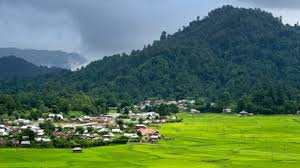11 October 2025 Indian Express Editorial
What to Read in Indian Express Editorial( Topic and Syllabus wise)
Editorial 1: India’s evolving growth measurement and economic transformation
Context:
The articles discuss India’s evolving industrial and economic growth frameworks — through the revision of the Index of Industrial Production (IIP) base year and India’s comparative GDP performance vis-à-vis major economies like the US, China, and Pakistan.
Introduction: Understanding India’s Growth and Measurement
India’s economic rise requires accurate tools to measure industrial progress and to compare its global growth standing. The Index of Industrial Production (IIP) is a crucial barometer reflecting industrial trends, while GDP comparisons reveal India’s performance in relative economic power and resilience.
The Need for IIP Base Year Revision
- Issue of Industrial Growth: With rapid expansion in services, the share of industry in Gross Value Added (GVA)remains around 22%, signaling untapped potential. Despite reforms like Make in India and Production Linked Incentive (PLI) schemes, updating the IIP’s statistical framework is essential for realistic policy evaluation.
- Rationale for Base Revision: The last base year (2011–12) no longer captures recent industrial diversification. A new base, proposed for 2022–23, will align the index with contemporary production trends, digital integration, and international standards (IRIIP 2010).
Key Improvements in IIP Revision
- Expanded Coverage:Inclusion of emerging products like LEDs, electric vehicles, solar cells, and pharmaceuticals.
- Updated Data Sources:Based on Annual Survey of Industries and GST data for improved accuracy.
- Factory Substitution:New methodology to track factories that close, relocate, or modify production lines.
- Seasonally Adjusted Series:To make data more comparable and forecasting more meaningful.
- This reform reflects India’s intent to strengthen data reliabilityand ensure evidence-based policymaking.
India’s Global Growth Trajectory: Comparative Insights
- India vs. Major Economies: According to the second editorial, India’s GDP (in constant US$ terms) has shown a sustained upward trajectory:
- Against the US:India’s economy has grown from 6 times smaller in 2010 to 7.5 times smaller in 2024, indicating faster growth.
- Against China:The gap has narrowed, though China’s pace has moderated.
- Against Pakistan:India’s economy is now 5 times larger, compared to 4.5 times a decade ago, reflecting strong policy and macroeconomic stability.
- Global Implications: The data shows India’s resilience amid global disruptions, supported by domestic demand, reforms, and a demographic dividend, making it a key engine of global growth in the 21st century.
Value Addition for UPSC Answers
- Related GS Topics:
- GS Paper III:Economic growth, industrial policy, infrastructure, and inclusive development.
- GS Paper II:Government policies and their impact on sectors.
- Government Schemes Mentioned:UDAN, Make in India, PLI, Digital India, GST integration.
- Data Source References:MoSPI, IIP, GVA, IRIIP, Annual Survey of Industries.
- Ethical Dimension (GS IV):Transparency, accountability, and accuracy in data collection are vital for good governance.
Conclusion:
- Together, both editorials underline India’s commitment to accurate economic measurement and sustainable growth.
- A revised IIPensures better industrial planning, while robust GDP performance reflects India’s emerging global role.
- As India pursues its Viksit Bharat 2047 vision, credible data and adaptive policies will remain the cornerstones of inclusive and resilient growth.
Editorial 2: In Arunachal, India’s Story
Context:
The editorial showcases Arunachal Pradesh as a model of sustainable development blending tradition, connectivity, and modern innovation.
Introduction: Tradition Rooted in Modern Progress
Jyotiraditya M. Scindia, Union Minister for Development of North Eastern Region, highlights Arunachal Pradesh as a symbol of India’s unity in diversity where tradition coexists with modern aspirations. The state, through its people and initiatives, embodies the spirit of Ashtalakshmi, representing diversity, opportunity, and inclusivity in the Northeastern region.
Connectivity and Infrastructure: Bridging the Margins:
- A major focus is on connectivity-led transformation, particularly through the UDAN (Ude Desh ka Aam Nagrik)scheme and Donyi Polo Airport at Hollongi.
- Under PM Modi’s vision, airports in the Northeastincreased from 9 to 17, improving accessibility and economic integration.
- Infrastructure here acts not only as a physical connector but also as a gateway to socio-economic participationfor remote communities.
- This aligns with the Government’s “Act East Policy”and the Digital Northeast Vision, aimed at bridging developmental asymmetries.
Culture and Sustainability: The Soul of Development
It emphasizes that development in Arunachal is eco-conscious and culturally inclusive.
- At the Ziro Music Festival, bamboo-based infrastructure, eco-tourism, and local artistry demonstrated a model of sustainable livelihoods.
- Tribal crafts and designs reflect “Vocal for Local”, aligning with Atmanirbhar Bharat
This blend of art, sustainability, and entrepreneurship underlines cultural resilienceas a pillar of progress.
Digital and Women-led Entrepreneurship:
- Scindia highlights transformative local stories such as Naara Aaba, a women-led winery founded by Rita Takhe, producing kiwi, apple, and guava wines.
- Her success story exemplifies grassroots entrepreneurship, women empowerment, and innovation.
- It reflects PM’s “Local to Global”call and the Digital India mission, where technology enables small entrepreneurs to access markets and customers online.
Sustainable Innovation and Rural Transformation:
- Arunachal’s model integrates waste management, renewable energy (solar lamps), and organic farming, reflecting SDG-aligned development.
- The Digital Northeast Visionshowcases how technology and tradition can co-create sustainable communities through cashless payments, eco-tourism, and digital marketplaces.
National Integration and Cultural Pride:
- Events like the Ziro Festivaland experiences in Hong Village symbolize India’s pluralism. The author’s engagement with local regiments and tribal communities reinforces national integration, patriotism, and mutual respect values deeply rooted in constitutional fraternity and unity in diversity.
Conclusion: A Microcosm of India’s Future
- Arunachal Pradesh stands as a living example of inclusive, sustainable, and confident India—rooted in culture yet oriented towards the future.
- It demonstrates that regional developmentmust respect local traditions while embracing modernization and innovation. The state embodies the “Sabka Saath, Sabka Vikas, Sabka Vishwas, Sabka Prayas” spirit, making it a model for other hill and border states.
![]()


